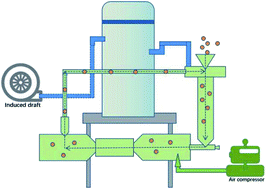Gas–solid two-phase flow (GSF) mechanochemical synthesis of dual-metal–organic frameworks and research on electrochemical properties†
Abstract
As an alternative approach for conventional mechanochemical synthesis, a novel gas–solid two-phase flow (GSF) synthetic technique for the mechanochemical synthesis of dual metal–organic frameworks (DMOFs) was reported for the first time. The prepared CoMn2(BTC)2 was characterized by FT-IR, DTA, TG/DTG, and XRD studies. The results indicated that CoMn2(BTC)2 (BTC = 1,3,5-benzenetricarboxylate) was successfully synthesized after 10 min at a rate of 60 kg h−1. CoMn2O4 microspheres were also prepared via the CoMn2(BTC)2 precursor method and characterized using FT-IR, XPS, XRD, SEM, EDS, and BET methods. The electrochemical properties of the as-prepared CoMn2O4 were investigated, and the GSF results showed that the microsphere electrodes of CoMn2O4 had a high specific capacitance (969 F g−1) at a current density of 1 A g−1 in 3 M aqueous KOH solution.



 Please wait while we load your content...
Please wait while we load your content...